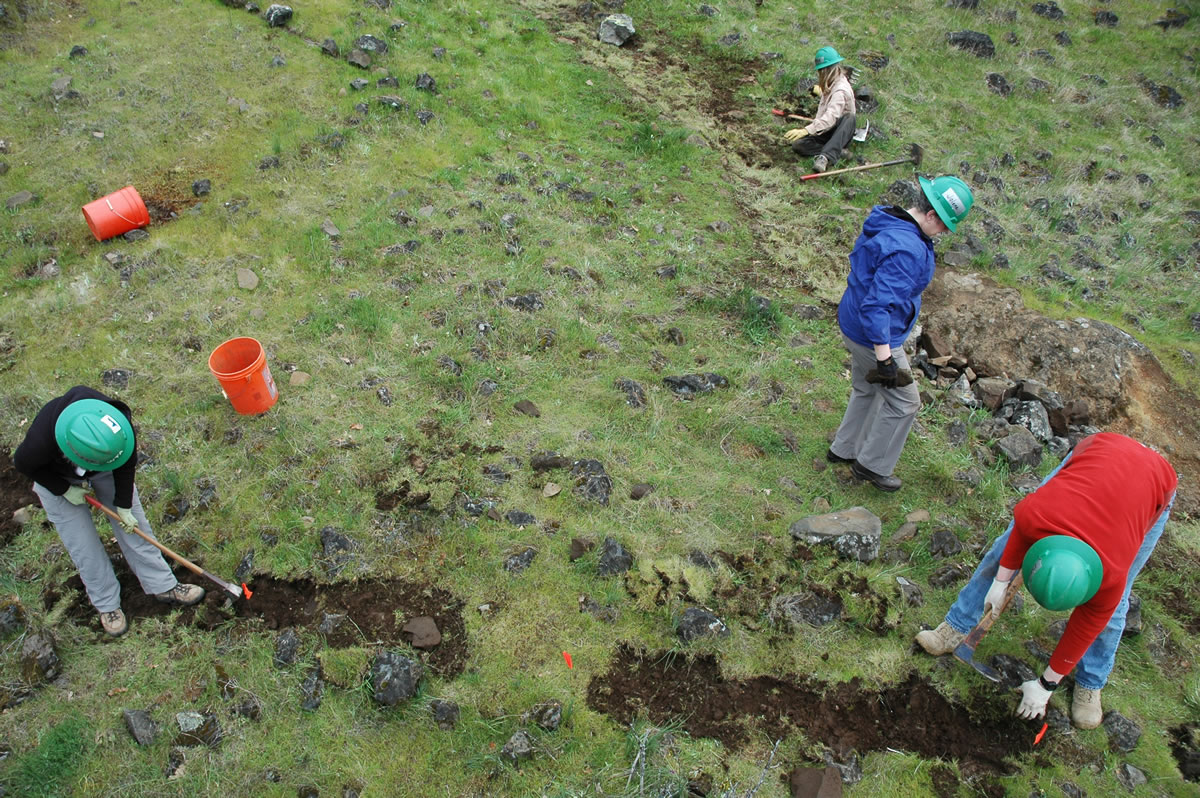Nicholas Travers of Portland pounded the replacement sod in with his fist, ironically deconstructing tread as part of a long-term effort to improve the popular trail network at Coyote Wall and Catherine Creek in the Columbia River Gorge National Scenic Area.
Travers was part of a crew of almost two dozen volunteers in late March who rerouted about 400 feet of the Labyrinth Trail. Portions of the existing route were returned to as natural a condition as possible, while new tread was added at a stable location.
“The Labyrinth trail was a high priority for the Forest Service to fix the erosion problems, so it’s one of the first projects we took on,” said Ryan Ojerio, Southwest regional manager for the Washington Trails Association.
While 400 feet of trail doesn’t seem much for a weekend’s worth of labor, working in the open terrain of the Coyote Wall area requires extra effort, Ojerio said.
“If we were building trail, instead of building and deconstructing, we could probably double that,” he said.
“We’re being very cautious to put sod in and decompact the soil (on the decommissioned route). Up in the woods, you could just drag a bunch of tree branches across the trail and let it grow back.”
The Forest Service owns almost 4,700 acres in the Burdoin Mountain, Coyote Wall and Catherine Creek areas of western Klickitat County. It’s a gorgeous area with a dry climate, low elevation, stunning views, wildlife and spectacular blooms of lupine, desert parsley and balsamroot in spring.
It is very popular with hikers and mountain bike riders, particularly in winter and spring when other areas are too wet or under snow. Hunters use the area in the fall, plus there are inholdings of private property.
The area is crisscrossed with trails, all of them created by riders and hikers.
The Forest Service started a formal planning process for the area in 2007. It proved to be contentious. The initial plan was appealed, and finally completed in January of 2011.
The plan calls for reducing the trail mileage from 31 to 19.4 and rerouting in situations where trails are to close to creeks or go through sensitive wildlife habitat.
A popular route beneath the cliffs of Coyote Wall was eliminated because it crosses private land.
Once done, the trail network will be signed and look more like a typical Forest Service system.
But the Forest Service has no money for the trail system. So volunteers from the Columbia Area Mountain Bike Advocates, Hood River Area Trail Stewards, Northwest Trail Alliance and Washington Trails Association are doing the work.
“It’s all being done by volunteers, every laborious foot,” said Stan Hinatsu, recreation manager for the Columbia River Gorge National Scenic Area.
He estimated it will take five years for the volunteers to get the system finished.
The Coyote Wall-Catherine Creek trails developed over time, Hinatsu said.
The Kreps family, who once owned a part of the property, allowed mountain bike riders to use roads and create some trails.
“There were trails already there when the Forest Service acquired the land,” he said.
More were created by users in recent years, resulting in the need for a formal network.
Hinatsu said there is no hard data to say if use is increasing in the Coyote Wall-Catherine Creek area, but he senses it is slowly.
“It’s more than just a local place,” he said. “It’s become a regional trail destination for mountain bikers.”
Volunteers in March were from as close as White Salmon and as far away as Bellevue.
“I want to get to know this area and haven’t really been in the Gorge, so this is a good way to learn,” Travers said. “I’ve always wanted to do trail work.”
Steven Moe has been a White Salmon resident since July.
“I just thought it would be a good thing to do, to give back,” Moe said. “It’s also a good way to learn the trail system.”




